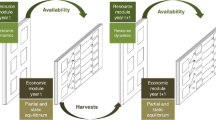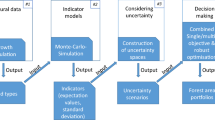Abstract
We propose a stochastic dynamic programming framework to model the management of a multi-stand forest under climate risk (strong wind occurrence). The preferences of the forest-owner are specified by a non-expected utility in order to separately analyze intertemporal substitution and risk aversion effects. A numerical method is developed to characterize the optimal forest management policies and the optimal consumption-saving strategy. The stochastic dynamic programming framework is applied to a non-industrial private forest-owner located in North-East of France. We show that the optimal decisions both depend upon risk and time preferences.


Similar content being viewed by others
References
Berck, P. (1979). The economics of timber: A renewable resource in the long-run. Bell Journal of Economics, 10, 447–462.
Caulfield, J. (1988). A stochastic efficiency approach for determining the economic rotation of a forest stand. Forest Science, 34, 441–457.
Chavas, J.-P. (2004). On impatience, economic growth and the environmental kuznets curve: A dynamic analysis of resource management. Environmental and Resource Economics, 28(2), 123–152.
Dhote, J. (2000). Composition, structure et résistance des peuplements. In J. C. Bergonzini & O. Laroussinie (Eds.), Les écosystèmes forestiers dans la tempête. Paris: ECOFOR-MAP.
Epstein, L., & Zin, S. (1989). Substitution, risk aversion and the temporal behavior of consumption and asset returns: A theoretical framework. Econometrica, 57, 937–969.
Epstein, L., & Zin, S. (1991). Substitution, risk aversion and the temporal behavior of consumption and asset returns: An empirical analysis. Journal of Political Economy, 99, 263–286.
Gong, P., & Löfgren, K.-G. (2005). Impact of risk aversion on optimal rotation age. Umea: Scandinavian WP no666, Swedish University of Agricultural Sciences.
Guo, B. (1994). Recherche d’une sylviculture optimale à long terme pour les peuplements forestiers équiennes. Ph.D. dissertation. Nancy: ENGREF.
Haight, R., Smith, W., & Starka, T. (1995). Hurricanes and the economics of loblolly pine plantations. Forest Science, 41(4), 675–688.
Hall, R. (1988). Intertemporal substitution in consumption. Journal of Political Economy, 96, 338–357.
Howitt, R., Reynaud, A., Msangi, S., & Knapp, K. (2005). Estimating intertemporal preferences for natural resource allocation. American Journal of Agricultural Economics, 87(4), 969–983.
Johansson, P., & Löfgren, K. (1985). The economics of forestry and natural resources. Oxford, UK: Blackwell.
Judd, K. (1998). Numerical methods in economics. Cambridge: M.I.T Press.
Kangas, J. (1994). Incorporating risk attitude into comparison of reforestation alternatives. Scandinavian Journal of Forest Research, 9, 297–304.
Knapp, K., & Olson, L. (1995). Dynamic resource management: Intertemporal substitution and risk aversion. American Journal of Agricultural Economics, 78, 1004–1014.
Koskela, E., & Ollikainen, M. (1999). Timber supply, amenity values and biological uncertainty. Journal of Forest Economics, 5(2), 285–304.
Lyon, K., & Sedjo, R. (1983). An optimal control theory model to estimate the regional long run timber supply. Forest Science, 29, 798–812.
Mitra, T., & Wan, H. (1985). Some theoretical results on the economics of forestry. Review of Economic Studies, 52, 263–282.
Normandin, M., & Saint-Amour, P. (1998). Substitution, risk aversion, taste shocks and equity premia. Journal of Applied Econometrics, 13, 265–281.
Peltola, J., & Knapp, K. (2001). Recursive preferences in forest management. Forest Science, 47(4), 455–465.
Picard, O., Robert, N., & Toppan, E. (2002). Les systèmes d’assurance en forêt et les progrès possibles. Paris: Fédération Nationale des Syndicats de Propriétaires Forestiers Sylviculteurs, IDF.
Pukkala, T., & Kangas, J. (1996). A method for integrating risk and attitude toward risk into forest planning. Forest Science, 42(2), 198–205.
Reed, W. (1984). The effects of the risk of fire on the optimal rotation of a forest. Journal of Environmental Economics and Management, 11, 180–190.
Salo, S., & Tahvonen, O. (2002). On the optimality of a normal forest with multiple land classes. Forest Science, 48, 530–542.
Salo, S., & Tahvonen, O. (2003). On the economics of forest vintages. Journal of Economic Dynamics and Control, 27, 1411–1435.
Salo, S., & Tahvonen, O. (2004). Renewable resources with endogenous age classes and allocation of land. American Journal of Agricultural Economics, 86(2), 513–530.
Samuelson, P. (1976). Economics of forestry in a evolving society. Economic Inquiry, 14, 466–492.
Schelhaas, M.-J., Nabuurs, G.-J., & Schuck, A. (2003). Natural disturbances in the european forests in the 19th and 20th centuries. Global Change Biology, 9, 1620–1633.
Sedjo, R., & Lyon, K. (1990). The long-term adequacy of world timber supply, report. Washington, DC; Resources for the Future RFF.
Stainback, G., & Alavalapati, J. (2004). Modeling catastrophic risk in economic analysis of forest carbon seques tration. Natural Resource Modeling, 17(3), 299–317.
Stollery, K. (2005). Climate change and optimal rotation in a flammable forest. Natural Resource Modeling, 18(1), 91–112.
Tahvonen, O. (1998). Bequests, credit rationing and in situ values in the faustmann-pressler-ohlin forestry model. Scandinavian Journal of Economics, 100(4), 781–800.
Tahvonen, O. (2004). Optimal harvesting of forest age classes: A survey of some recent results. Mathematical Population Studies, 11, 205–232.
Tahvonen, O., & Salo, S. (1999). Optimal forest rotation with in situ preferences. Journal of Environmental Economics and Management, 37, 106–128.
Taylor, R., & Forston, J. (1991). Optimum plantation planting density and rotation age based on financial risk and return. Forest Science, 37(3), 886–902.
Uusivuori, J., & Kuuluvainen, J. (2005). The harvesting decisions when a standing value forest with multiple age-classes has value. American Journal of Agricultural Economics, 87(1), 61–76.
Valsta, L. (1992). A scenario approach to stochastic anticipatory optimization in stand management. Forest Science, 38, 430–447.
Vanniére, B. (1984). Tables de production pour les forêts françaises Nancy: E.N.G.R.E.F Press.
Author information
Authors and Affiliations
Corresponding author
Additional information
The authors would like to thank participants at the international conference on Economics of Sustainable Forest Management in Toronto, at the PARIS 1 seminar on Environmental and Natural Resource Economics, at the 2004 Applied Microeconomics Conference in Lille and at the 13th annual conference of the European Association of Environmental and Resource Economists at Budapest.
Rights and permissions
About this article
Cite this article
Couture, S., Reynaud, A. Multi-stand Forest Management under a Climatic Risk: Do Time and Risk Preferences Matter?. Environ Model Assess 13, 181–193 (2008). https://doi.org/10.1007/s10666-007-9121-7
Received:
Accepted:
Published:
Issue Date:
DOI: https://doi.org/10.1007/s10666-007-9121-7




